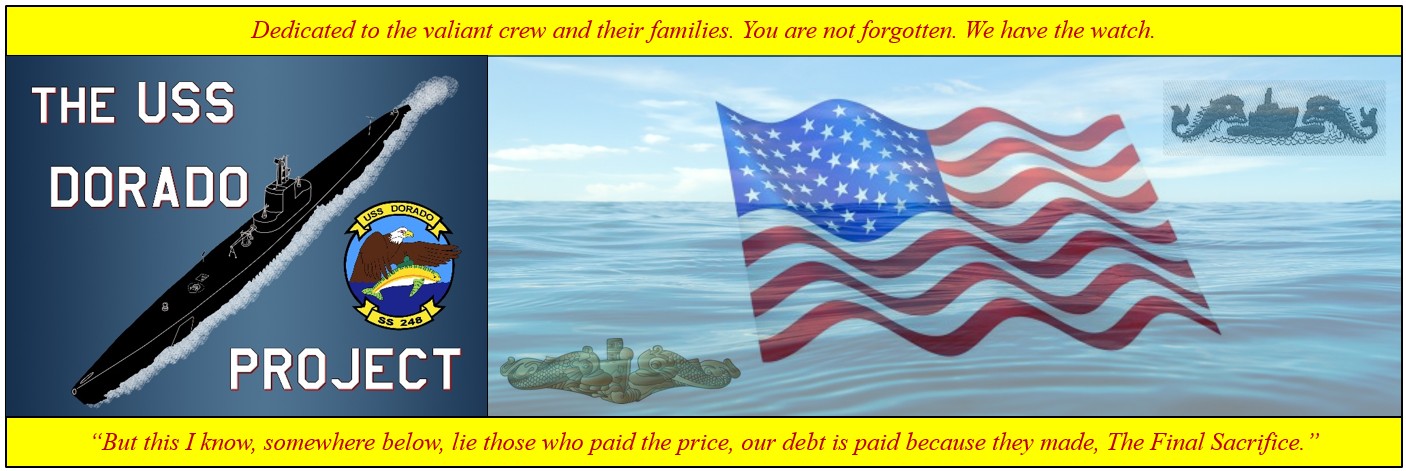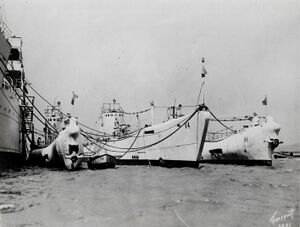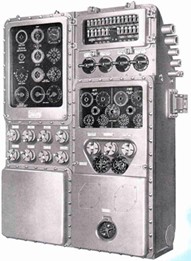Dorado (SS-248): Difference between revisions
Pbcjohnston (talk | contribs) |
Pbcjohnston (talk | contribs) |
||
| Line 42: | Line 42: | ||
<div style="text-align: justify;"><span style="color:#000000"> | <div style="text-align: justify;"><span style="color:#000000"> | ||
[[File:Mk III TDC.jpg|right|thumb|300px|<small>The Mk III TDC. PK on the left, AS on the right.</small>]]<div style="text-align: justify;"><span style="color:#00008B">The Gatos (like many of their predecessors were equipped with an advanced version of the Torpedo Data Computer (TDC), an analog computer that was used to accurately aim torpedoes. The Mark III TDC consisted of two components: the Position Keeper (PK) and the Angle Solver (AS). Using automatic inputs for the submarine’s own course and speed, the operators input the target’s length, estimated speed, and angle on the bow based on periscope observations or radar tracking. The PK then solved the equations for motion integrated over time, and provided a continuous estimate of the target’s position. The AS took that input from the PK, combined it with the tactical properties of the torpedo, and solved for the needed torpedo gyro angle. It then transmitted this information to the weapons in the tube, | [[File:Mk III TDC.jpg|right|thumb|300px|<small>The Mk III TDC. PK on the left, AS on the right.</small>]]<div style="text-align: justify;"><span style="color:#00008B">The Gatos (like many of their predecessors were equipped with an advanced version of the Torpedo Data Computer (TDC), an analog computer that was used to accurately aim torpedoes. The Mark III TDC consisted of two components: the Position Keeper (PK) and the Angle Solver (AS). Using automatic inputs for the submarine’s own course and speed, the operators input the target’s length, estimated speed, and angle on the bow based on periscope observations or radar tracking. The PK then solved the equations for motion integrated over time, and provided a continuous estimate of the target’s position. The AS took that input from the PK, combined it with the tactical properties of the torpedo, and solved for the needed torpedo gyro angle. It then transmitted this information to the weapons in the tube, setting the gyrocompass and running depth of the weapons automatically so that they would turn to a course to intercept the target once they left the tube and run at the depth necessary to hit the target. This was a significant tactical advantage, and the TDC became the envy of the world's navies. | ||
Significantly, like all submarines built since the Salmon/Sargo-class, the Gato-class boats were built to an all-welded construction method, as opposed to the more traditional riveted method. Welding made for strong and resilient pressure hulls that could take a lot of punishment and still survive. | Significantly, like all submarines built since the Salmon/Sargo-class, the Gato-class boats were built to an all-welded construction method, as opposed to the more traditional riveted method. Welding made for strong and resilient pressure hulls that could take a lot of punishment and still survive. | ||
Revision as of 14:51, 14 June 2025

| Main Page | Latest News & Updates | The Submarine | The Crew | Photographs | The Loss Scenario | The Myths | The Aircraft | Research Documents |
Introduction to the Gato-class submarines
A "fleet submarine" was a large submarine intended to operate directly with the main fleet battle line composed of battleships, aircraft carriers, cruisers, and destroyers. Their role was to range out ahead of the battle line and act as scouts. They were to find the enemy and report on their composition, course, and speed. They were to then conduct attrition attacks designed to weaken the enemy fleet prior to the main gun battle with the U.S. battle line. To accomplish this mission the submarines had to have a long range, high speed, and be heavily armed. The subs also had to be quite large in order to fit all of the necessary equipment to achieve these qualities into the pressure hull.
Early development

The nine V-class submarines ended up being largely experimental in nature, as the Navy tinkered with several concepts brought out by WW I. The class not only consisted of fleet submarines, but also a specialized mine layer, two commerce raiding cruiser submarines, an open ocean patrol submarine, and two small fleet boats. The boats were either too big, too small, or they were too experimental in nature to be fully successful. All of them were underpowered, as diesel engine technology in the United States badly lacked in comparison with European designs.
The experience with the T and V-classes had taught the Navy what worked and what didn't when it came to building a fleet submarine, and by 1933 they had moved beyond the experimental stage and began solid progress towards what would become the Gato-class. The ten Porpoise-class boats of 1933-1937 and the 16 Salmon/Sargo-class boats of 1936-1939 were largely successful and proved to be solid steps up the developmental ladder. The 12 Tambor/Gar-class submarines of 1939-1941 were the ultimate peacetime refinement of the fleet submarine concept. Large, fast, and powerful these boats were highly regarded by the Submarine Service and their crews. When the FY-41 appropriation programs were being discussed, it was decided to "freeze" the design at that point for mass production. These boats became the famed Gato-class.
The Gato-class

The boats were engined with four now fully refined Fairbanks-Morse or General Motors Winton diesel engines in a "diesel-electric" arrangement, where the engines drove only electrical generators, and the electricity produced was sent to electric motors on each propeller shaft, or to recharge the batteries used for submerged propulsion. The FM and GM engines were hardy, rugged, reliable, and well liked by the crews and provided excellent service. Unfortunately, eight submarines of the class were equipped with Hooven, Owens, & Rentschler (HOR) 99DA diesel engines, which for several reasons were complete failures. Those subs were eventually re-engined with GM Winton units during wartime overhauls.
In early 1942 the Gatos and other USN submarines began to be equipped with a remarkable device: radar. The first sets were designated SD and were used to detect incoming aircraft while the submarine was surfaced. This gave the crew an advanced warning of danger in the area and gave the commanding officer information vital to keeping his boat safe. The second type was designated SJ and was used to detect surface targets day or night and in any weather condtions. The SJ radar was accurate enough to precisely track targets even when they couldn't be seen visually. The tactical advantage that this gave USN submarines can not be overstated; indeed it was a prime factor in the eventual overwhelming success of the submarine campaign against Japan.

Significantly, like all submarines built since the Salmon/Sargo-class, the Gato-class boats were built to an all-welded construction method, as opposed to the more traditional riveted method. Welding made for strong and resilient pressure hulls that could take a lot of punishment and still survive.
The Gatos also had air-conditioning, a complete refrigeration plant for storage of food, stills for making plenty of fresh water, clothes washing machines, and enough bunks so that every crew member could have one of their own. Food was of uniformly very high quality, the best in the fleet, prepared in compact galleys that turned out the food in prodigious quantities. These were luxuries virtually unheard of in foreign navies, but they were absolute necessities if the crew were expected to conduct 60-90 day patrols in the warm waters of the Pacific Ocean.
These qualities made the Gato-class an ideal member of the nearly 232 submarines that the USN commissioned during the war. Along with the previous classes, and the follow-on Balao and Tench-classes, the Gatos had a significant and disproportionate effect on the outcome of the Pacific war, shooting the bottom out of the Japanese Merchant Marine and crippling operations of the Imperial Japanese Navy.
It is important to note that the Gato-class submarines were built to two very similar, but slightly divergent designs. The boats built at the Navy Yards used a detailed design prepared by Portsmouth. Boats built at EB and Manitowoc used the Portsmouth design as a base, with EB making numerous, but relatively minor, changes that facilitated production to their unique methods. Manitowoc was designated as a follow-on yard to EB and used the EB plans and part numbering scheme. One of the major differences was that the government boats used the Fairbanks-Morse engines while the EB design used the GM Wintons. There were slight internal and external differences as well, and these will be explained below.
Wartime modifications

Dorado, as completed, was configured as a Gato-class Mod 3, with the forward and after ends of the conning tower fairwater cut away, the periscope shears unplated, the port side anchor removed, an SJ radar installed forward of the shears, an SD radar installed aft of the shears, and 20 mm Mk 5 gun mounts installed on the forward and aft fairwater gun decks. The bridge remained at its original height. The 4"/50 caliber Mk 12 gun was mounted forward of the fairwater. Compare the photo of Jack at left with the photo of Growler above and the extent of the modifications becomes apparent. It was in this configuration that she departed Submarine Base New London on October 6, 1943, bound for the Panama Canal.
Class Construction
In 1919 the Navy designated the Portsmouth Navy Yard in Kittery, Maine as the lead design center for submarines. The Navy had changed the submarine acquisition paradigm with this move, as all previous submarines had been designed and built by civilian firms, with the Navy having little say in the detailed design process. Portsmouth also had four (later expanded to ten) building slips and facilities where the boats could be constructed and launched. To supplement Portsmouth, the Mare Island Navy Yard in Vallejo, CA (north of San Francisco) also built submarines, and prior to the start of Gato-class construction Mare Island had built six high quality submarines.
The Electric Boat Company (EB) had been a major player in submarine construction up to 1941. Indeed, they had built the Navy's first submarine, the USS Holland in 1898 and had been very successful in designing and building submarines for the USN and some foreign navies up through 1925, acquiring a near monopoly. For several reasons EB had a falling out with the Navy in 1925, and for six years between the S-class and the last of the V-class in 1931 EB did not build a single submarine for the USN. However, with fences mended, in 1931 EB was brought back into the submarine construction fold to build Cuttlefish (SS-171) and were entirely successful. EB actually built the bulk of the Porpoise, Salmon/Sargo, and Tambor/Gar submarines and by the start of the construction of the Gato-class in the fall of 1940 the yard had five building slips along the Thames River in Groton. By the spring of 1941 that had been expanded to 12.
However, even this expanded capacity across two government and one civilian yard was not going to be enough. In September of 1940 the Navy contracted with the Manitowoc Shipbuilding Company in Wisconsin to build 14 additional Gatos. Manitowoc eventually built 14 Gato-class boats to plans supplied by EB. The boats were launched sideways into the Manitowoc River, completed, and then run through their initial sea trials (including their first dives) in Lake Michigan. Once completed the boats were floated on a barge down the Illinois River to the Mississippi River, then put back into the water at New Orleans, where they were delivered to the Navy. Manitowoc had a fine reputation in the Submarine Service, with their boats being well built and rugged, despite their unconventional origin.
The Victory Yard

The first three boats laid down at the Victory Yard were the Dace (SS-247), Dorado (SS-248), and Flasher (SS-249) on ways 2, 3, and 4 in July, August, and September of 1942.
USS Dorado (SS-248)
Specifications
| Length (Ft-In) | Beam (Ft-In) | Surf. Displ. (Tons) | Subm. Displ. (Tons) | Surf. Prop. | Surf. Shaft HP | Aux. Power | Subm. Prop. | Battery/Cells | Subm. Shaft HP | Surf. Speed (Kts) | Subm. Speed (Kts) | Surf. Range (NM@Kts) | Subm. Endurance@Kts |
|---|---|---|---|---|---|---|---|---|---|---|---|---|---|
| 311-9 | 27-3 | 2060 | 2424 | 4x GM 16-248 (DE) | 5400 | 1x GM 8-268A (DE) | 4x General Electric motors | 2x Exide VLA47B/126 ea | 2740 | 20.25 | 8.75 | 11000@10 | 48 hrs@2 |
| Fuel Cap. (U.S. Gal) | Patrol Endurance (days) | Test Depth (Ft) | Torp Tubes (B/S) | Tube Size (In) | Torp Load | Deck Gun | Crew (O/E) |
|---|---|---|---|---|---|---|---|
| 116000 | 75-85 | 300 | 6/4 | 21 | 24 | 1x 4"/50 Mk 12 | 10/71 |
Sea Trials
Page created by:
Thaddeus Weaver & David Johnston
©2025 - Thaddeus Weaver & PigBoats.COM
West Warwick, RI, Norfolk, VA
ussdoradoproject@gmail.com